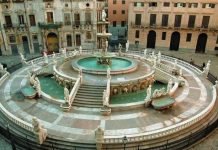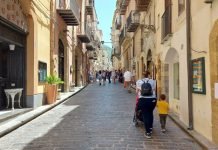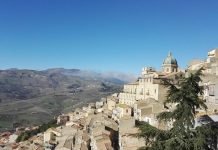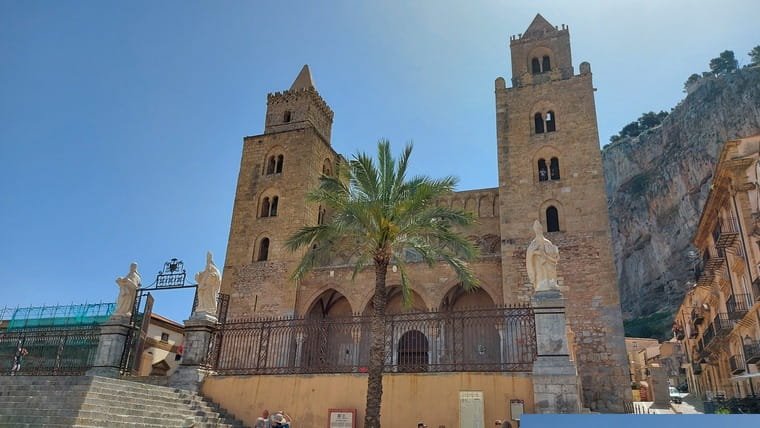
Cefalù is an enchanting medieval town just a few minutes from Palermo. It is one of the most popular tourist destinations in the whole of Sicily, and reading what follows you will easily understand why.
A brief historical note: The original name of Cefalù was Kephaloidion, a name given to it by its founders (the Greeks) and meaning “head”. Later the Romans changed the name to Chephaloedium. This name is due to the characteristic head-shaped promontory that overlooks Cefalù.
As promised, now let’s stop talking about history and try to understand what there is to see in Cefalù and why people come here from all over the world!
First, however, we would like to remind you that by following this link you can find our itinerary for visiting the historic center of Cefalù on foot.
Indice
What to see in Cefalù
There are certainly many things to see in Cefalù, many of which have an important historical value. The center of Cefalù in particular has a clear medieval imprint that makes every glimpse, every step pleasant.
But let’s go in order and try to understand what Cefalù is famous for and what you absolutely cannot miss.
The Cathedral of Cefalù
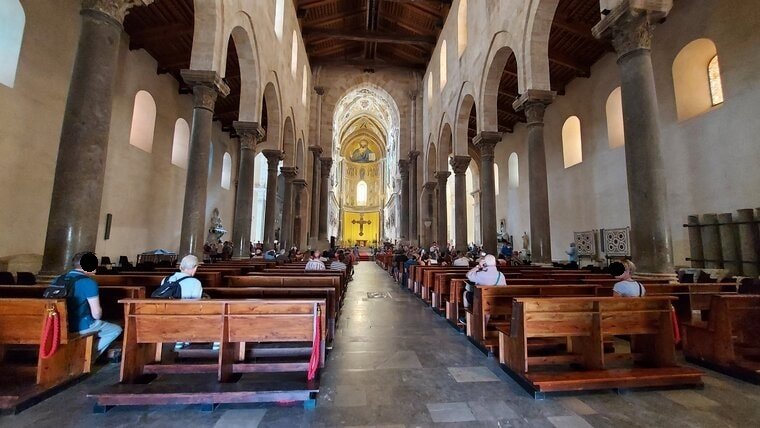
The Cathedral of Cefalù, also known as the “Cathedral of Cefalù”, is a minor basilica that is based on Norman and Byzantine architecture. It was built starting in 1131 under the reign of King Roger II, who had planned this place for his burial and that of his wife.
This majestic building has been declared a World Heritage Site by UNESCO and is considered one of the best examples of Norman architecture in Sicily.
Iconic is the large staircase to be climbed before you can access the churchyard terrace from which you can access the Porta Regum, which allows access to the Cathedral.
The façade is characterized by two characteristic towers on the sides, reminiscent of the typical towers of the churches of Normandy. In the center of the portico there are three arches, the central one with a full arch.
Inside we find three naves (the plan is a Latin cross) separated by 8 columns on each side on which stand beautiful Corinthian capitals on which beautiful full arches rest.

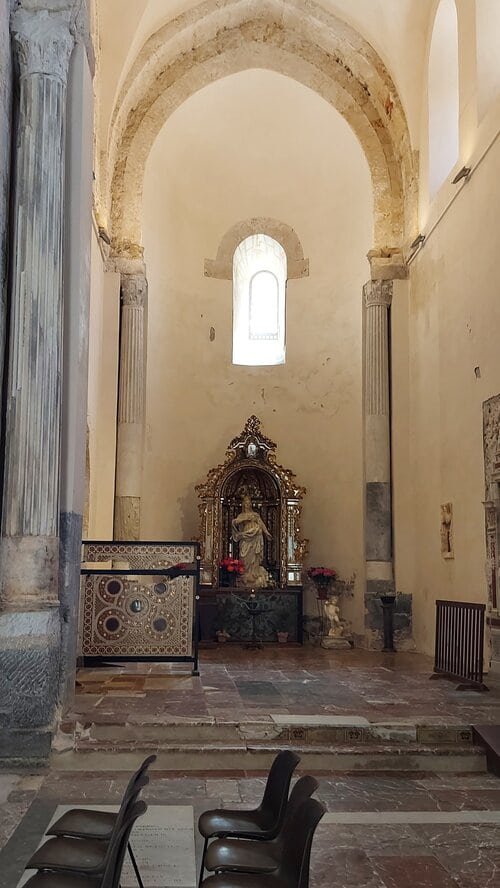
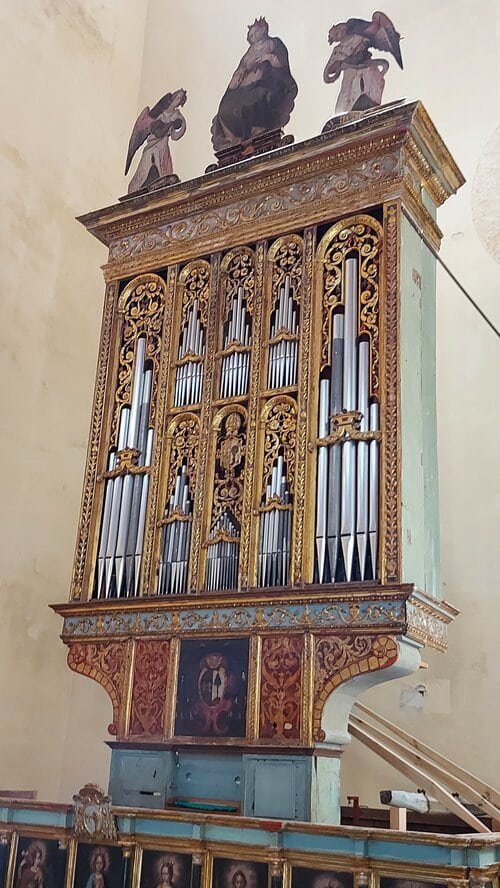
Also very interesting to visit is the cathedral’s cloister, the oldest in Sicily, characterized by a rectangular plan and a riot of arches and capitals adorned with stories concerning the Old and New Testaments.
History of the Cathedral of Cefalù
As mentioned, the first work on the construction of the Cathedral of Cefalù began in 1131, at the behest of Roger II of Hauteville as a sign of gratitude to the patron saint of the city (the Holy Savior) following a miraculous landing that saved him from a shipwreck.
According to tradition, the King had promised to build a church where he would have touched land again “If I come out alive from the waves and I am not bait for the fish …”.
Here he also had the stone sarcophagi arranged that should have housed the body of him and his wife. In reality, on his death, which occurred in 1154 in Palermo, his remains were placed inside the Palermo Cathedral.
For this reason, in 1215 Frederick II had the sarcophagi transferred to Palermo for himself and his father Henry VI.
The Cefalù Castle
Let’s start from a fact: the view here is unique.
No matter where you have been in the world, what you will see from up here will never happen to you again.
To get to the top of the Rocca di Cefalù you can start from Via Pitrè (we are 350 meters away from the beach) and access the Rocca di Cefalù Park.
It is a rather challenging climb, 268 meters high, and is not recommended for those who have no physical preparation.
Clearly its dominant position was strategic for the defense of the village, an extraordinary vantage point.
Dating back to the 12th century, the Cefalù Castle was used until the 19th century before being abandoned. There were anciently two lines of walls: one below to protect the village, one higher to defend the Rocca. The structure has a pentagonal plan with two towers, one to the East and one to the North. Inside there was also a small courtyard.
As you climb towards the top you will notice several architectural remains that testify to the ancient human settlements. Among these the Temple of Diana (at about 150 meters above sea level) and the Cefalù Castle (at the top).
Access to the Rocca di Cefalù costs 5 euros for adults, while children between 6 and 14 years old and over 65 pay half.
The Temple of Diana
The Temple of Diana is certainly one of the things to see in Cefalù, especially if you love history when it intertwines with mystery. It is a megalithic structure built in the 9th century BC (although later completed in different periods) whose intended use is still unclear today.
Here we are halfway up the Rocca di Cefalù, therefore quite far from the city center and therefore the hypothesis that the Temple was used as a place of worship should be ruled out. Some scholars hypothesize that it was a sanctuary with strategic functions for sightings over the sea, given its dominant position.
The presence of an ancient cistern confirms the hypothesis that it was a place of worship, with reference to the water deities.
The Tourist Pier
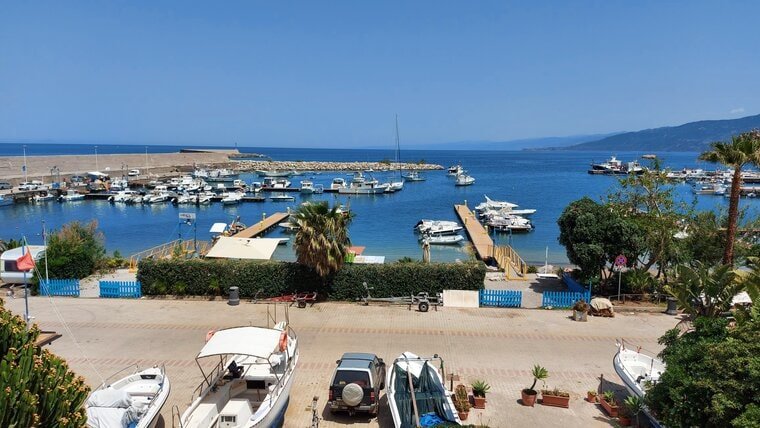
The Cefalù Tourist Pier (also called “Porto Nuovo”) is located in the Presidiana area, east of the city center and exactly under the Rocca di Cefalù.
It is protected by a concrete breakwater and there are several piers, suitable for mooring boats of all sizes, from fishermen’s boats to boats that exceed 20 meters in length.
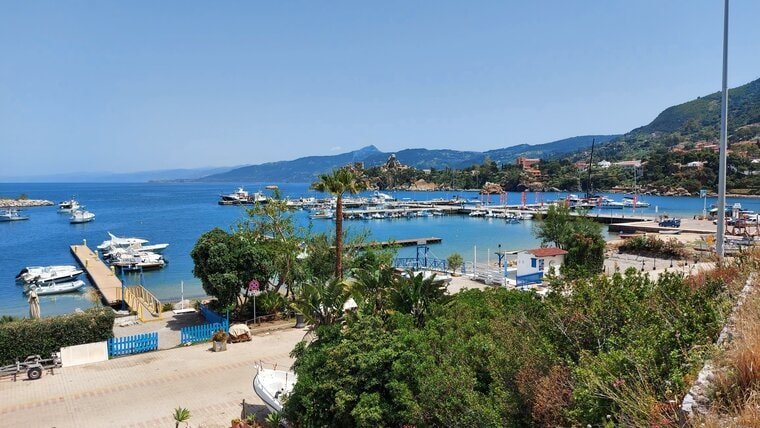
There is also a fuel dispenser for boats.
If you have rented a boat from Palermo to sail to the Aeolian Islands, you will surely want to stop in Cefalù and then dock here.
The view from the sea towards the interior is also suggestive, given the beautiful promontory (the Kalura) that almost borders the sea and the Cefalù lighthouse.
It is important to note that along the road that leads to the port it is possible to park your car for free, therefore if you have booked a hotel in the area you can take advantage of this opportunity.
Useful information for yachtsmen about the Cefalù tourist pier:
- Address: Via Presidiana, 90015 Cefalù, Palermo
- Position 38°02′,12 N; 14°02′,19 E
- Important to know: presence of submerged rocks near the head of the windward pier.
- Presence of the Tallarita rock and the Scoglio dei Passeri.
- Seabed: sand.
- Seabed depth: up to 5.00 meters.
- Capacity: about 250 berths.
- Services on the quay: electricity, water and fuel.
The Megalithic Walls
Given its position on the sea that made it particularly “vulnerable”, already in the 500 BC in Cefalù an imposing city wall was built to protect those who were used to arriving from the sea to plunder the city.
The looters arrived from the sea typically in those periods of the year when the olives were pressed to make oil or when the harvest was taking place.
The city walls of Cefalù are still visible today and start from the Piazza Garibaldi Square to envelop the entire Rocca. There were four gates that allowed entry into the city, one of which was the aforementioned Porta Pescara.
The megalithic walls made Cefalù an impenetrable village, so much so as to make it difficult even in the centuries to come to settle by the peoples who imposed themselves in this area of Sicily.
Porta Pescara (also called Porta Marina or Porta dei Vicerè)
Porta Pescara is located in Via Vittorio Emanuele 105, a few steps from the Old Port of Cefalù. This is certainly one of those places where you can indulge in taking romantic or artistic photos, given its particular structure with a Gothic arch and the splendid view that you can see beyond the gate. It is the only survivor among the four gates of the city that characterized the ancient city walls. Also to be noted is the coat of arms of the Kings of Sicily placed right above the arch.
The Mandralisca Museum
The Mandralisca Museum in Cefalù is an interdisciplinary museum that houses a vast collection of works of art, ancient objects and precious artifacts. The highlight of the collection is the “Portrait of an unknown sailor” by Antonello da Messina, one of the masterpieces of Italian Renaissance painting.
The museum houses a picture gallery, an archaeological collection, a malacological collection, a numismatic collection, furniture and precious objects.
The address is Via Mandralisca 13, in the heart of the historic center of Cefalù, a two-minute walk from the Piazza del Duomo. This is the official website of the Mandralisca Museum, we recommend consulting it because days and opening hours vary depending on the period of the year.
The beaches of Cefalù
You cannot truly understand what is beautiful about Cefalù if you first do not visit the seafront and its beautiful beaches.
Consider that we are talking about about 2km of sandy coastline, in which there are many lidos and free beaches, plus the area between Porta Giudecca and the Cefalù lighthouse where there is a further km of rocks and rocks, easy to reach thanks to special staircases located in Via Giudecca.
Below we provide some useful information on the most famous beaches of Cefalù and its surroundings.
Cefalù Beach

Cefalù Beach, also known as “Lido Cefalù” or simply “Lungomare” by the locals, is very close to the town center (officially named Lungomare Giuseppe Giardina) and stretches for almost two kilometers.
It is a beautiful beach of fine sand, accessible by several steps distributed along the entire overlying road.
There are about ten equipped beaches and some stretches of free beach, so you can choose whether to pay for services or not. On average, the cost for two sunbeds and an umbrella is €25, a price that in some beaches becomes €30 in August. In any case, after 3:00 pm, almost all the beaches in Cefalù apply a discount of about 50%.
Certainly, we can include it among the most beautiful beaches in Sicily.
By the way, we repeat that it is a very central beach and close to the town center, so there are dozens of bars, ice cream parlors, restaurants, pizzerias, sandwich shops and pubs right in front of it where you can also spend the after-dinner.
Mazzaforno Beach

Mazzaforno Beach is just over 10 minutes drive from the town center of Cefalù, towards Palermo. It is a small beach 400 meters long in all, where sand alternates with pebbles or rocks.
To reach it, you need to park your car and walk the last stretch, which can be a bit treacherous even due to the presence of rocks or uneven ground, so keep this in mind if you have children.
The peculiarity of this beach is that you feel enveloped in a very particular naturalistic context, due to the presence of pine trees and spontaneous vegetation on the rocks that surround the area.
There are also two beaches and a bar, surely it is a beach to visit if you love silence as well as the beautiful sea.
Torre Conca Beach
Torre Conca beach is located in Pollina, about 25 minutes by car from the center of Cefalù, moving towards Messina.
It is a small bay with about 350 meters of sandy beach and a few pebbles, surrounded by overhanging rocks on the sea that make the whole thing particularly suggestive.
Here the sea takes on shades ranging from blue to emerald, truly a wonder for the eyes. If you go with children, consider that the seabed is deep right from the start. There are also two beaches and a bar, as well as a free shower.
Sant’Ambrogio Beach
Sant’Ambrogio Beach is about 15 minutes by car from the center of Cefalù, towards Messina.
Here the water is a spectacle, but the real magic is what you can see even turning your back on the sea, since we are practically at the foot of the Madonie Park.
The first section is a small coastline about 150 meters long with sand and pebbles, the second (also known as “Playa Degli Uccelli“) is instead about 1.5 km long and there are some beaches and a seafront restaurant.
The nature of the place is wild, and over time the vegetation has taken away a lot of space from the beach, but this area is the right one if you want to experience the clean sea away from the crowds.
Kalura Beach
Kalura Beach is about 5 minutes by car from the center of Cefalù, but can also be reached on foot, and is located right behind the Rocca. It is a small bay immersed in the green, with little sand and beautiful rocks.
The water here is always clear and the seabed is particularly interesting and rich in vegetation, so it’s a good idea to bring your mask with you.
There are equipped areas where you can rent sunbeds and umbrellas, and unlike Lido Cefalù, here you can enjoy more peace and quiet.
However, consider that in the afternoon the sun no longer reaches the beach, so it is preferable to go there in the morning.
Old Port Beach
One of the places that you will remember with greatest pleasure thinking of your holiday in Cefalù is the Old Port, also called “Il Molo” by many.
First of all, let’s say that the Old Port is the ideal place to take beautiful photos of Cefalù, especially at sunset, considering that from here you can see the Rocca, the entire coastline of Cefalù and the top of the Cathedral.
At the Old Port of Cefalù it seems like going back in time, since you have the impression of still being in an ancient fishing village where the boats were moored almost under the house, on that tongue of sand that today sees many tourists relax in the sun.
This is the beach of the locals before it is the beach of tourists, so it is easy to find locals here. If you want, you can move to the adjacent pier to take a dip, take some pictures or watch the fish from the dock.
Map of Cefalù
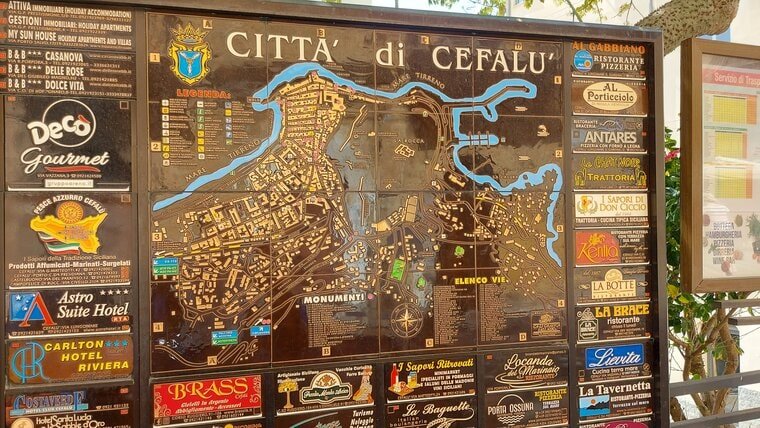
Tour and Activities in Cefalù
Cefalù and the surrounding area are well-suited for beautiful tours and activities of all kinds. In our opinion, the most interesting ones to do are:
- Mountain bike excursion in the Madonie Park
- Jeep excursion in the Madonie Park
- Sailing boat trip with skipper off the coast of Cefalù, with exploration of the seabed
- Two-day trip to visit Palermo (the distance between Cefalù and Palermo is 70km)
Things to do in Cefalù
If your holiday in Cefalù is imminent, or if you are simply planning your travel itinerary in advance, know that there are many things you can do in this beautiful medieval town.
Below we list those that we have personally tried and that we recommend you do to make your holiday even more special.
Relax on the beach

If we are talking about things to do in Cefalù, we must start with its sea. As you have seen, there are many beaches in the area, some of which can be reached on foot, such as the “Old Port“, the “Lungomare” or the “Kalura” beach.
Choose according to your preferences (crowded or more secluded, sand or rocks, close or far from the center) and relax enjoying the clear waters that interest the entire coast of Cefalù.
Climb the Rocca di Cefalù
If you love trekking or simply enjoy doing some light physical activity even when you are traveling, climbing the Rocca di Cefalù could be for you.
Reach the Temple of Diana or follow the path and climb even higher to the Cefalù Castle: it will be pleasant to do this type of activity immersed in the greenery and, when you discover the panorama below, you will see that it will have been truly worth it.
On days when visibility is particularly good, from the top of the Rocca it is also possible to see Alicudi and Filicudi, part of the Aeolian archipelago.
Admire the view from the Bastione di Capo Marchiafava

The Bastione di Capo Marchiafava is located at the end of Piazza Francesco Crispi, a few tens of meters from the Old Port of Cefalù.
Climb the short staircase that leads to the Bastion and you will see how wonderful the surrounding panorama is: from West to East you will see a boundless sea and the splendid Cefalù coast.
This is the perfect place to take splendid photos at sunset or in broad daylight.
Enjoy the view from the Old Port

Reach the Old Port of Cefalù, you will notice that there is a staircase that allows you to climb the megalithic walls to the end of the pier.
Certainly from here you can take beautiful photos in the direction of the Cefalù beach and the characteristic little houses on the sea, but this is absolutely the place we recommend to immortalize the sunset.
In fact, in summer, between 20:00 and 20:15 pm approximately, from here you can admire the sun of a beautiful red color “going out” in the sea. Here you will take the most beautiful photos of your holiday in Cefalù, trust us.
Coffee, ice cream or granita in Piazza Duomo

One of the things to do in Cefalù is to enjoy a good coffee, ice cream or Sicilian granita sitting at the tables in Piazza Duomo.
Here the prices are not exaggerated as in other tourist places, and for a few euros you will have the opportunity to taste something typical while contemplating the beauty of the Cathedral of Cefalù and the square itself.
Shopping
n Cefalù there is certainly no shortage of shopping opportunities: Corso Ruggero and Via Vittorio Emanuele in particular are full of bazaars and small shops where you can find souvenirs, beach items, clothing, gifts and of course restaurants.
If you can, try to choose those shops that favor local crafts and the Cefalù community.
Local crafts of Cefalù

In Cefalù you will not find particular shops that concern major brands, but there are many businesses that offer handmade products.
For example, there are many small shops in Cefalù where you can find Sicilian ceramics (most of which come from the nearby town of Santo Stefano di Camastra), wooden artifacts, home accessories and gifts.

If you want to treat yourself to a little gift, or bring someone a souvenir of your holiday in Cefalù, a handicraft product is the perfect choice!
Location near Cefalù
…and if you want to explore the surroundings of Cefalù? In this case too, you are spoiled for choice.
For example, you could:
- Reach the nearby Madonie Park with its countless trails and natural beauties.
- Take a boat trip and reach the Aeolian Islands or explore the Cefalù coast.
- Visit Palermo: here you can find the most important things to see in Palermo.
- Discover the nearby Borgo di Gangi, elected “Borgo dei Borghi 2014”.
- Reach the characteristic Borgo di Castelbuono.
- Take a day trip to visit Enna.
- Spend two days in the Taormina and Giardini Naxos area.
- Reach Ustica by ferry from Palermo.
Nightlife in Cefalù: where to go and what to do in the evening?
The nightlife in Cefalù starts quite early, considering that aperitifs are available as early as 6:00 pm. One of the lively areas of Cefalù is certainly the seafront, where there are dozens of pubs and bars one next to the other.
Also within the historic center of Cefalù there are various places where you can spend the evening, and most of these are located near the Old Port. If you love dancing, there are several discos both in the center and on the beach.
Cefalù: Frequently Asked Questions (FAQs)
What is Cefalù famous for?
Cefalù is famous mainly for its beautiful Cathedral, the unspoiled sea and its beautiful beaches, the medieval washhouse, the megalithic walls, the Rocca and the Castle.
What is beautiful in Cefalù?
Everything you can read above, including the hospitality of the locals with whom you will have the opportunity to interact.
How many days does it take to visit Cefalù?
If you are referring to the time it takes to visit all the places of interest in Cefalù, 3 days are enough. If instead you go to Cefalù to experience its beautiful sea and take the opportunity to visit the most important sites, it is a good idea to stay a whole week.
What to see in Cefalù in one day?
Given that in one day you can see little, we recommend that you walk around the historic center of Cefalù and the Old Port. This way you will also be able to see the Cathedral and the ancient washhouse.
What is the sea like in Cefalù?
The stretch of sea that goes from Cefalù to Capo d’Orlando and Milazzo is the most beautiful in North Sicily … you will notice the turquoise reflections and the splendid seabed for which we remind you to bring a diving mask with you.
How to get around Cefalù?
Cefalù is small, especially for the “tourist” part which is limited to the historic center, Old Port and waterfront. These are small distances, on the order of a few hundred meters depending on where you are staying, which can be easily covered on foot.
In any case, in Cefalù there is a city bus service, active from April 1st to October 31st. You can find timetables and stops here https://www.busradar.it/pullman/cefalu/sommatino/
What to eat in Cefalù?
Cefalù is in the province of Palermo, it does not have particular typical dishes and therefore here you can taste both the typical dishes that you would also find in the capital and those typical of the Madonie. From Sicilian street food to fish-based dishes, therefore, there is only the embarrassment of choice.
The Cefalù train station
Arriving in Cefalù by train from Palermo is a good idea. The regional trains used for this route are comfortable and modern, and the cost is € 7.10 each way per person. A train leaves about every hour and the travel time is about 50 minutes.
The Cefalù train station is located in Via Passafiume 40 and is about 600 meters from the waterfront, so you can easily walk unless you are staying in the Duomo di Cefalù area. In that case, it is better to take a taxi as the distance is about 1km and doing it with suitcases under the sun may not be pleasant.
How many kilometers are there from Palermo to Cefalù?
From Palermo to Cefalù there are exactly 70km.
How to Get from Palermo to Cefalù
The fastest way to get from Palermo to Cefalù is by car. The journey takes about 35-40 minutes and covers 70 km (43.5 miles). Take the A19 motorway towards Messina and exit at “Buonfornello“. There is a toll of €1 to pay.
There is a regular train service between Palermo and Cefalù. Trains depart from Palermo Centrale station approximately every hour and take about 50 minutes to reach Cefalù. Tickets cost €7.10 each way.
There are several bus companies that operate services between Palermo and Cefalù. Buses depart from Palermo Centrale bus station and take about 50 minutes to reach Cefalù. Tickets cost between €7 and €10 each way, depending on the company and the time of travel.
Parking in Cefalù
Painful Note: Assuming you’ll be visiting Cefalù between June and August, finding parking for your car won’t be easy. Non-residents are not allowed to access the historic center by car, except for loading and unloading luggage.
You can park for free on white lines. Yellow lines are reserved for specific categories, such as taxis and NCC (Noleggio con Conducente, or rental with driver). Blue lines indicate paid parking, starting at €0.50 per hour depending on the area.
On the Cefalù seafront, you’ll find numerous parking spaces (paid), as well as guarded parking lots (check rates for cars, motorcycles, and campers beforehand).
There are around twenty white-lined parking spaces on the other side of Cefalù, on Via Giudecca, but you’ll need luck to find a free one.
Be careful because there’s a camera at the small roundabout that records unauthorized entries into the limited traffic zone: don’t go past the roundabout and turn back.


